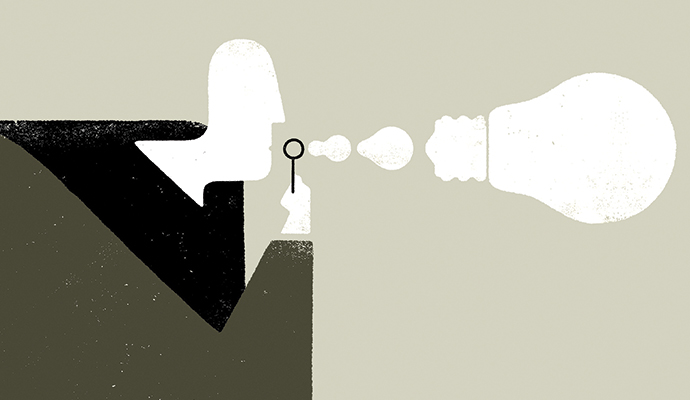How to Spark “Next-Gen” Creativity
Leading for creativity isn’t about being an artistic free spirit — it’s about having the necessary skills to think in ways that get things done.
As robots take over more and more “dirty, dull, and dangerous” jobs from humans and automation assumes the knowledge work once done by people, the vocations that require complex, creative thinking will remain the domain of the living.
This point was driven home in a recent World Economic Forum (WEF) report, which forecasts expected advances in automation, artificial intelligence, and other areas that constitute Industry 4.0. The changes, already unfolding, could — and likely will — be profound, and include shifts in even the most essential job skills.
The report compares the top skills needed in 2015 and those predicted to be critical in 2020 (which is just a few heartbeats away). Quality control and active listening drop from this list — perhaps new technology will take care of these. Emotional intelligence and cognitive flexibility take their place. What I found most interesting is that creativity rockets from the number 10 spot all the way up to number three.
But before you unleash your inner van Gogh, know that creativity isn’t just about being visually artistic (or acting like the office free spirit). According to the human resources and other senior executives surveyed by the WEF, 52 percent of jobs will require complex cognitive abilities such as “creativity, logical reasoning, and problem sensitivity” as a core capability — a sort of “next-gen” creativity.
I’m a former communications creative director from the days when holding a creative role meant you were one of the few in the office who could forego a suit and allocate plenty of “out of the box” thinking time. But today’s workplace, and the workplace of the future, requires an approach to creativity that promotes free thinking yet also has a focus on getting projects completed, products launched, and services humming along.
However, just telling people to “be more creative” without further definition can be frustrating for all concerned. Leaders should work for clarity about what creativity means for a specific role, and to do this, it’s helpful to think about what creativity means in various contexts. Today, creativity can range from a blank canvas (the ability to think way outside the box) to tightly bounded (the skill of solving within fixed parameters). I spoke to several people who use different forms of creativity and asked them: “What does creativity mean in your work?” They revealed four principles useful to any business leader.
Know which boundaries to draw — and which to erase. I started with Bill Hartman, who leads the innovation strategy team at design consultancy Essential Design. This is the kind of firm that companies turn to for help in creating new products and services. Hartman studied to be a fine artist and then pursued a career in industrial design.
Hartman paraphrased the creative challenge as articulated by two of his design heroes, Charles and Ray Eames: “How do we design great utility in a world with finite resources?” Charles Eames described design as “a plan for arranging elements in such a way as best to accomplish a particular purpose.” Not a lot of blank canvas there, yet the Eameses’ creations remain design icons.
Hartman went on to describe the MoSCoW model, used by many designers, as another useful tool for talking about creativity: Define what the end product or service must do, should do, could do, and won’t do (at least in this iteration). “This helps designers set creative priorities,” he said. The same can be said of most any department. Knowing as many specific parameters about a project as possible, yet allowing employees the leeway to be creative with how they make the project a reality, helps keep people on track and moving forward with a clear direction.
Create an environment that fosters creativity — and that doesn’t mean buying foosball tables. To understand creativity in a completely different domain, I went to Samir Kapuria, senior vice president and general manager of Symantec’s cybersecurity services. One of the challenges his business faces is to counteract that which has yet to happen.
Just telling people to “be more creative” without further definition can be frustrating for all concerned.
“We orient our teams to anticipate the future and novel attack events,” he told me. “We have to be creative because our enemy is constantly changing its tactics and techniques.” To foster the team’s thinking, Symantec creates “immersive simulation experiences to stimulate their ability to look for new things.” It is a low-risk environment, yet one that creates “the contextual challenges of overwhelming information and constant change.”
Kapuria extends creative thinking to the organization itself. “You need a self-evolving organization and a culture that is willing to take risks in the interest of the mission and the business,” he said. He has created an environment that rewards risk taking for innovation by celebrating those who are willing to push their thinking to secure the digital economy.
Creating immersive simulation experiences and rewarding risk taking are two effective steps leaders can take to drive creativity among their ranks. These are proven techniques with results that far outshine those of the dot-com–era days of foosball tables and fish tanks.
Decide where improvisation is most appropriate. I also spoke with Jake Hawkes, the current proprietor of family-owned Hawkes Wines in California’s Alexander Valley. Like every good farmer, he acknowledges that variables such as the weather are critical yet completely outside of his control. “My job as winemaker requires constant improvisation and creative problem solving to turn what we have into something we can sell,” he said. And it isn’t just the grapes — success requires navigating the interdependent functions of farming, winemaking, and marketing, all areas in which creativity has different meanings.
He explained a creativity-driven choice for differentiation he has made: While some vineyards strive for year-over-year consistency to build brand loyalty, he has embraced “vintage variability,” in which each year’s production is a distinctive reflection of “time, climate, and place.” His informative, humorous, and often irreverent notes that accompany wine club shipments are one way that he cultivates an appreciation of that variability among his customers.
In some instances, there will be variables that are beyond a leader’s control. In Hawkes’s case, it is the weather. Elsewhere, it may be budget, or the software or hardware on hand. Allow these limitations to spark creativity and improvisation elsewhere. When one mechanism is sticky, perhaps another can be oiled with some unexpected thinking.
Dwell on the question, not the answer — and give it time to emerge. Creativity coach Julie Daley told me that new ideas can’t be forced. “Everyone is creative,” she said. “It is our nature. We are educated out of it. Creativity is not artistic ability. Creativity can be seen as an adventure. We are wired for adventure — part of us still wants that.” She advised taking your ego out of the outcome. “The more personally invested you are in the solution, the less possibility you will see.”
She advised dwelling on the question — the unknown — and not investing in an answer too quickly. “When you get adamant about outcomes, you exit creativity,” she said. Leave time for incubation. “You have to step away from the problem for a bit. That’s often when the ‘aha’ moment comes.”
The increasing importance of creativity at work has the potential to make many roles more interesting and rewarding — if we’re both creative and smart in how we approach them. For leaders, the job is to frame the challenge appropriately, ensure clarity of the governing principles, create fertile conditions, and then have the wisdom to step back to let people contribute their best.






